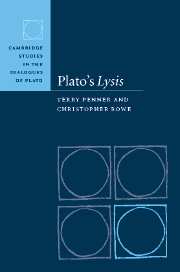Book contents
- Frontmatter
- Contents
- Preface
- PART I AN ANALYSIS OF THE LYSIS
- 1 203a1–207b7: the cast assembles, and the main conversation is set up
- 2 207b8–210d8 (Socrates and Lysis): do Lysis' parents really love him?
- 3 210e1–213c9: Socrates and Menexenus – how does one get a friend?
- 4 213d1–216b9: Socrates and Lysis again, then Menexenus – poets and cosmologists on what is friend of what (like of like; or opposite of opposite?)
- 5 216c1–221d6: what it is that loves, what it really loves, and why
- 6 221d6–222b2: the main argument reaches its conclusion
- 7 222b3–e7: some further questions from Socrates about the argument, leading to (apparent) impasse
- 8 223a1–b8: the dialogue ends – people will say that Socrates and the boys think they are friends, but that they haven't been able to discover what ‘the friend’ is
- 9 203a1–207b7 revisited
- PART II THE THEORY OF THE LYSIS
- Epilogue
- Translation of the Lysis
- Bibliography
- Index of names
- Index of subjects
5 - 216c1–221d6: what it is that loves, what it really loves, and why
Published online by Cambridge University Press: 22 September 2009
- Frontmatter
- Contents
- Preface
- PART I AN ANALYSIS OF THE LYSIS
- 1 203a1–207b7: the cast assembles, and the main conversation is set up
- 2 207b8–210d8 (Socrates and Lysis): do Lysis' parents really love him?
- 3 210e1–213c9: Socrates and Menexenus – how does one get a friend?
- 4 213d1–216b9: Socrates and Lysis again, then Menexenus – poets and cosmologists on what is friend of what (like of like; or opposite of opposite?)
- 5 216c1–221d6: what it is that loves, what it really loves, and why
- 6 221d6–222b2: the main argument reaches its conclusion
- 7 222b3–e7: some further questions from Socrates about the argument, leading to (apparent) impasse
- 8 223a1–b8: the dialogue ends – people will say that Socrates and the boys think they are friends, but that they haven't been able to discover what ‘the friend’ is
- 9 203a1–207b7 revisited
- PART II THE THEORY OF THE LYSIS
- Epilogue
- Translation of the Lysis
- Bibliography
- Index of names
- Index of subjects
Summary
216c1–217a2
216c1 ‘But let's go on and consider this too, whether the friend isn't perhaps eluding us to a still greater extent (eti mallon), in truth being none of these things, but [sc. rather] what is neither good nor bad simply, perhaps [houtō pote?], becoming friend of the good.’
‘How do you mean?’ [Menexenus] said.
‘Zeus!’ I said. ‘I don't 216c5 know – I'm dizzy myself at the impasse in [i.e. the aporia of] the argument, and it looks as if, as the old proverb goes, “the beautiful is friend (philon)”. At any rate it seems like something soft and smooth and slippery; 216d1 which is actually why, perhaps, it is easily slipping through our fingers and getting away from us, that is, because it's the sort of thing that does that. For I say that the good is beautiful; what about you – don't you think so?’
‘I do.’
‘Then I say – and here I'm speaking as a prophet – that it's the neither good nor bad that's friend of the beautiful and good; 216d5 and as for the things with a view to which I utter my prophecy, I'll tell you what they are. It seems to me that it's as if there are some three kinds of things, the good, the bad, and the neither good nor bad; what about you?’
‘To me too,’ he said.
‘And that neither is the good friend to the good, nor the bad to the bad, nor the good 216e1 to the bad, just as the previous discussion (logos) too stopped us from saying; it remains, then (dē), if indeed anything is friend to anything, that the neither good nor bad should be friend either of the good or of what is of the same sort as itself. […]
- Type
- Chapter
- Information
- Plato's Lysis , pp. 99 - 156Publisher: Cambridge University PressPrint publication year: 2005



